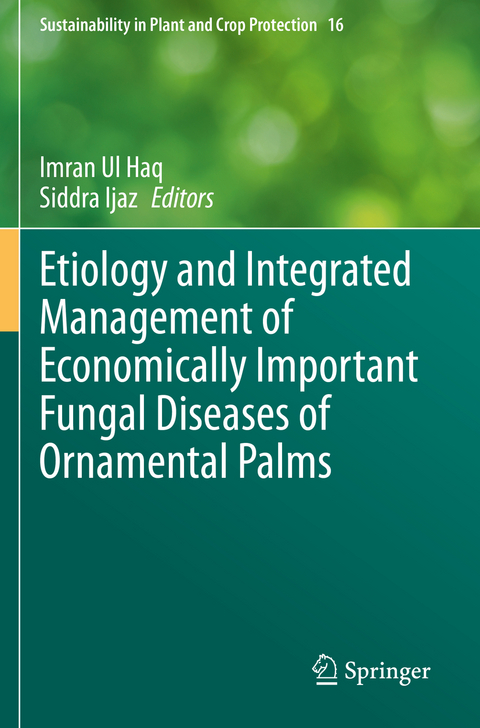
Etiology and Integrated Management of Economically Important Fungal Diseases of Ornamental Palms
Springer International Publishing (Verlag)
978-3-030-56332-5 (ISBN)
Historically it was general belief that plant pathogens are not associated with human diseases. Since 19th century, several clinical reports are available indicating many plant pathogenic fungi (Aspergillus spp., Penicillium spp., Alternaria spp., Trichoderma spp., Fusarium spp., Curvularia spp. and Colletotrichum Spp) as novel agents of human diseases. Besides the association of fungal plant pathogens infecting ornamental palms, harbouring any of earlier mentioned or other fungal species (capable of causing certain diseases in human beings or pets) by the ornamental palms cultivation (either grown indoor or outdoor) is an important area of research to be explored and addressed thoroughly.
This book will provide the deep information regarding major fungal diseases of ornamental palms, their symptoms, disease identification, and etiology and management strategies. This book will also provide unique knowledge regarding the ornamental palms harbouring kinds of human fungal pathogens and their practical management at domestic and commercial scale, in order to make cultivation of these plant more beneficial for humans, animals and environment.
Dr. Imran Ul Haq is a Plant Pathologist and specialized in Fungal Molecular taxonomy. Currently he is Associate Professor and in-charge of Fungal Molecular Biology Laboratory as well as Fungal Molecular Biology Laboratory Culture Collection (FMB-CC-UAF), in the Department of Plant Pathology, University of Agriculture, Faisalabad, Pakistan. He is running different research projects funded by national and international agencies. His research interests are fungal molecular taxonomy, integration of nanotechnology with other control strategies for sustainable plant disease management. He has authored three Laboratory manuals, more than 50 research publications in well reputed, peer reviewed, high impacted national and international journals and book chapters. He is co-author of a book "Recombinant DNA Technology". He has edited a book "Plant Disease Management Strategies for Sustainable Agriculture through Traditional and Modern Approaches" published from Springer Nature platform.
Dr. Siddra Ijaz is a Molecular Biologist and is currently serving as Assistant Professor in the Center of Agricultural Biochemistry and Biotechnology (CABB), University of Agriculture, Faisalabad, Pakistan. She has several competitive research grants funded by national a well as international agencies, and established molecular biology laboratory. Her research focus includes plant genome engineering using transgenic technologies, genome editing through CRISPR/Cas9 and nanobiotechnology. She has authored two books "Molecular Basis of Life" and "Recombinant DNA Technology", besides, she is also the Editor of a book, Plant Disease Managment Strategies for Sustainable Agriculture through Traditional and Modern Approaches". She has more than 40 research publications in high impacted, peer reviewed national and international scientific Journals as well as several book chapters are also on her credit.
Part 1. Biology and Horticultural aspects of Ornamental Palms.- 1. Ornamental Horticulture: Economic importance, Current Scenario and Future Prospects (Iftikhar Ahmad, Hafiz Atta-Ur-Rehman and Muhammad Abdul Salam Khan).- 2. Ornamental Palms: Molecular taxonomy, Ecology and Distribution (Siddra Ijaz and Maria Babar).- 3. Cultivation and Growth constraints of Ornamental Palms (Muhammad Azam, Rashad Qadri, Muhammad Tahir Akram, Shaghef Ejaz).- Part 2. Economically Important Fungal Diseases of Ornamental Palms and their Management strategies).- 4. Fungal diseases of ornamental Palms: Etiology, pathogenesis and management (Imran Ul Haq, Qaiser Shakeel, Guoqing Li, Long Yang and Ifrah Rashid).- 5. Fungal diseases of Foxtail palm (Wodyetia bifurcate) (Rana M. Sabir Tariq, Saleem Shahzad and Abdul Qayoom Rajput).- 6. Fungal diseases of Cat palm (Chemaeodrea cataractarum), Bamboo palm (Chemaedorea seifrizii) and Cluster palm (Chamaedorea costaricana) (Qaiser Shakeel, Mingde Wu, Jing Zhangand Zia-ul-haq).- 7. Fungal diseases of Washingtonia palm (Washingtonia robusta) (Iqra, Nabeeha Aslam Khan, Muhammad Zunair Latif and Yasir Iftikhar).- 8. Fungal diseases of Golden palm (Dypsis lutescens) (Muhammad Taimoor Shakeel, N.I. Katis, Muhammad Mohsin Alam, Rashida Atiq and Qaiser Shakeel).- 9. Fungal diseases of Bismarckia palm (Bismarckia nobilis) (Rana M. Sabir Tariq, Saboohi Raza and Tanveer Ahmad).- 10. Fungal diseases of Date palm (Phoenix dactylifera) and Pigmy date palm (Phoenix roebelenii) (Imran Ul Haq and Nabeeha Aslam Khan).- 11. Fungal diseases of Alexandra palm (Archontophoenix alexandrae) and Queen palm (Syagrus romanzoffiana) (Adnan Ahmad, Muhammad Raheel, Qaiser Shakeel, Anjum Faraz and Khalid Pervaiz Akhtar).- 12. Fungal diseases of Ravenea palm (Ravenea hildebrandtii) (M. Zunair Latif).- 13. Fungal diseases of Royal palm (Roystonea regia) (Rabia Tahir Bajwa, Qaiser Shakeel, Muhammad Raheel and Ifrah Rashid).- 14. Fungal diseases of Lady palm (Rhapis excelsa)and Fishtail palm (Caryota mitis) (Muhammad Kaleem Sarwar, Rashda Naheed, Siddra Ijaz and Imran Ul Haq).- Par 3. Fungal Diseases of False Palm).- 15. Fungal diseases of Traveler's palm (Ravenala madagascariensis) (Rana M. Sabir Tariq and Tanveer Ahmad).- 16. Fungal diseases of Kangi palm (Cycas revoluta) (Anjum Faraz, Muhammad Zunair Latif and Owais Yaseen).
| Erscheinungsdatum | 12.11.2021 |
|---|---|
| Reihe/Serie | Sustainability in Plant and Crop Protection |
| Zusatzinfo | XI, 287 p. 8 illus., 7 illus. in color. |
| Verlagsort | Cham |
| Sprache | englisch |
| Maße | 155 x 235 mm |
| Gewicht | 462 g |
| Themenwelt | Naturwissenschaften ► Biologie ► Botanik |
| Schlagworte | Etiology of fungal diseases • forestry management • human fungal pathogens • integrated management • Molecular Diagnostics • Ornamental palms |
| ISBN-10 | 3-030-56332-4 / 3030563324 |
| ISBN-13 | 978-3-030-56332-5 / 9783030563325 |
| Zustand | Neuware |
| Haben Sie eine Frage zum Produkt? |
aus dem Bereich


